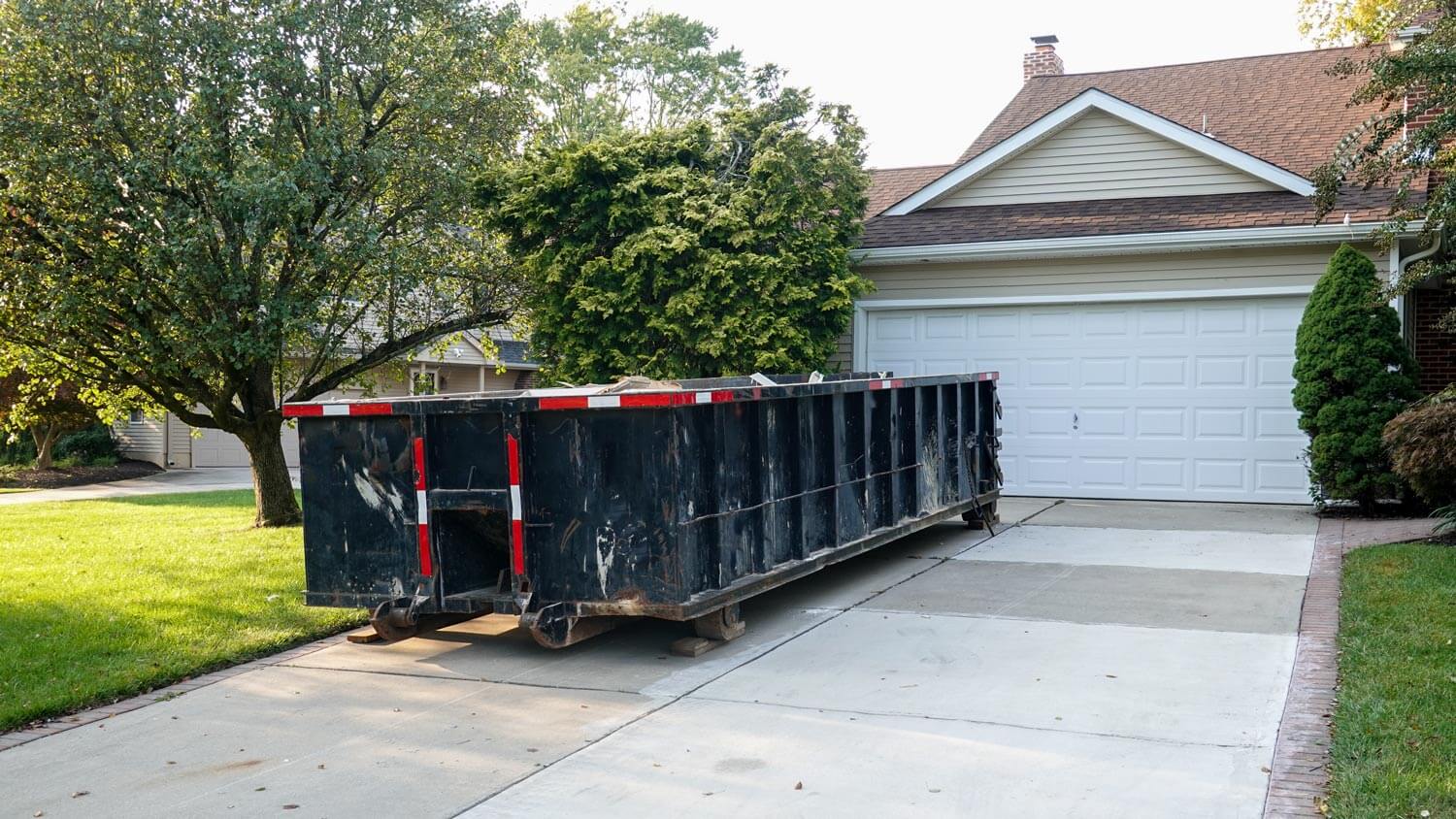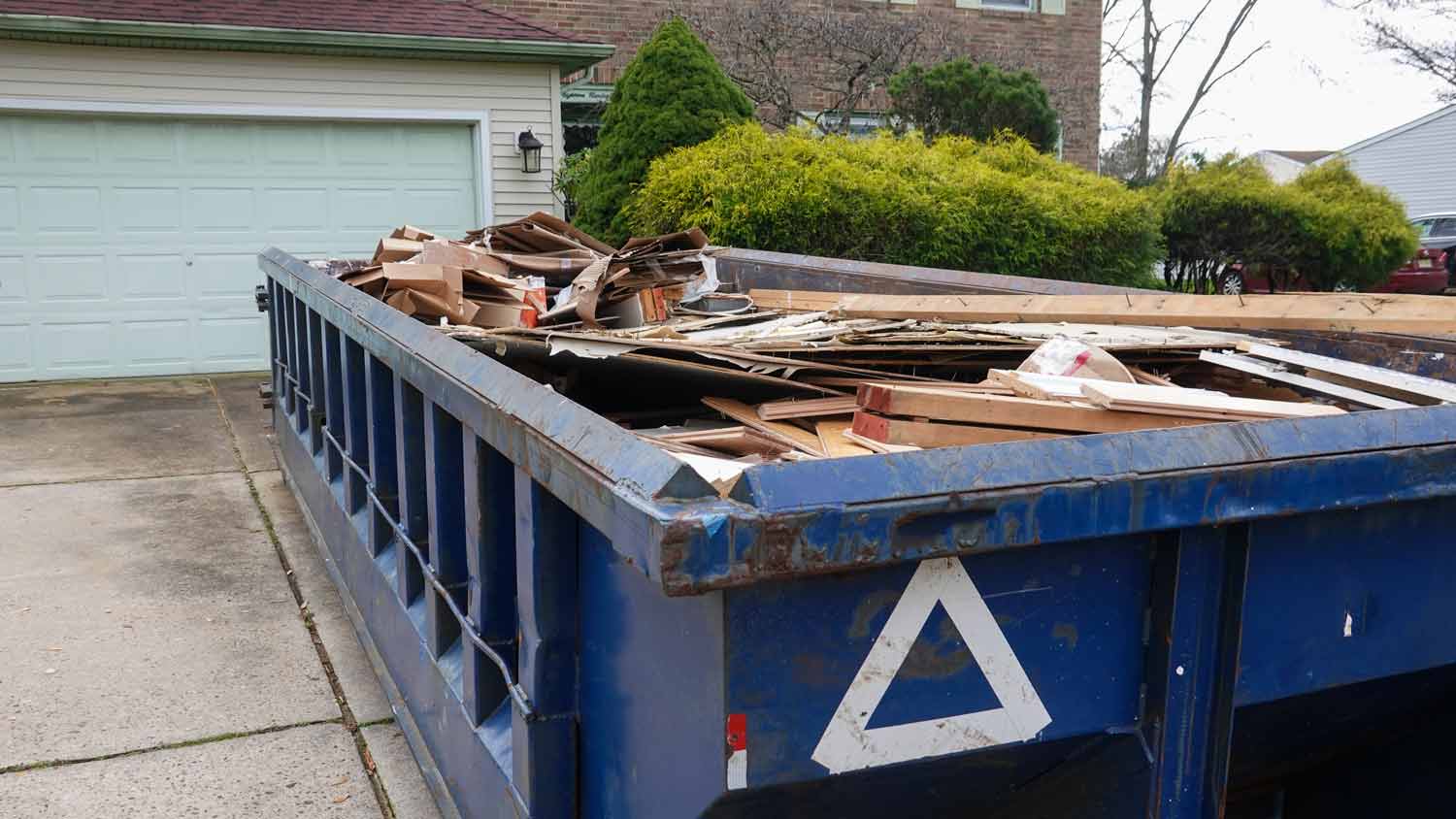
The cost to rent a dumpster averages between *X* and *X* depending on type, size and the rental period.
The right size dumpster makes project clean-up easy


Dumpsters come in 10-yard, 15-yard, 20-yard, 30-yard, and 40-yard sizes.
Weight capacity varies with dumpster size.
The right dumpster size will depend on the type of project and where the dumpster will be set up.
Whether you’re remodeling your kitchen, replacing your roof, or cleaning out your whole house, renting a dumpster is the easiest way to get rid of a large amount of trash or construction debris at once. It’s important to get the right size dumpster to fit everything you need to get rid of, but how do you choose the right one?
Learn what size dumpster you need for different projects and what to consider before renting one.

The type of dumpsters used for residential projects are called “roll-off dumpsters” and are delivered to your home on a truck and rolled into place on wheels. You fill the dumpster with waste and debris throughout your project. At the end of the contracted rental time, the truck returns to collect the full dumpster and dispose of its contents.
Just like there are different sizes of dump trucks, dumpsters come in a range of standard sizes to accommodate different amounts of waste and debris. Dumpsters are available in smaller 10-yard and 15-yard sizes, a medium 20-yard size, and large 30-yard and 40-yard sizes. Each size has its own weight capacity, so it’s important to know not just the dimensions of what you’re putting in the dumpster but also the total weight.

Different projects produce different amounts of trash or debris, so it’s a good idea to match the dumpster size to the type of project to ensure your dumpster meets your needs.
| Project Type | Recommended Dumpster Size |
|---|---|
| Home cleanout | 15 or 20-yard |
| Landscaping | 10 or 15-yard |
| Roofing | 10 or 20-yard |
| Kitchen remodel | 20 or 30-yard |
| Bathroom remodel | 15 or 20-yard |
| Home remodel | 30 or 40-yard |
A 15- or 20-yard dumpster is a good choice for a cleanout for most single-family homes. These dumpsters will easily fit in a driveway and can handle old furniture and large amounts of trash. Keep in mind that there are some items you can’t put in a dumpster, so check that everything you toss in is on the “approved” list.
You can't just throw anything into a dumpster rental. Fluorescent light bulbs, paint, tires, household cleaners, and food waste are just a few commonly prohibited items. Ask dumpster rental companies what you can and can't throw into their dumpsters before renting.
Landscaping projects can generate heavy waste like rocks, stumps, and dirt. A 10-yard dumpster will ensure you don’t exceed the weight limit before filling it up. For larger projects with lighter waste like leaves and brush, a 15-yard dumpster will give you the extra room you need.
Shingles are heavy, so filling up a too-large dumpster can put you over the weight limit. A smaller dumpster will prevent a load that’s too heavy to haul.
Match the size of your dumpster to the size of the area being remodeled. A bathroom remodel will likely need a smaller dumpster than a kitchen—just be sure it’s big enough to handle any discarded fixtures without exceeding the weight limit.

Choosing the right dumpster size involves a lot of variables, so it can be challenging to figure out what size you need. The following factors will help you pinpoint which size is right for your project.
Before renting a dumpster, you'll need to know what kind of debris you’re filling it with. Heavy loads like shingles, bricks, stones, or dirt will need a smaller dumpster to stay within the weight limits. Bigger, lighter loads like trash bags and household items can fill up a dumpster without weighing too much.
Renovations often involve a mix of debris, with large items like cabinetry and appliances. Larger dumpsters have high enough sides to accommodate these items and enough space to fit all the construction debris.
It’s important to factor in both the expected weight of your dumpster load and the amount of room it’ll take up. Staying within weight limits is critical for safe hauling, so check that the dumpster you’re renting has a weight capacity high enough for what you need. The debris volume is also a deciding factor—the dumpster needs to be big and tall enough so nothing is poking out over the top.
You’ll also need to consider dumpster placement before renting. Dumpsters can’t be placed just anywhere, and you’ll be limited by the space available. The dumpster rental company can tell you what the space requirements are for each size dumpster. If your driveway is narrow or hard to access, you may need a smaller dumpster.
Local regulations will dictate where you can place a dumpster and whether you’ll need a permit to do so. Always ensure you’re compliant with local laws when renting a dumpster.
It might seem like a no-brainer that a smaller dumpster will cost you less, but that’s not always true over the course of a project. A larger dumpster will have a higher up-front cost, but will be less likely to fill up early and need to be emptied before your project is done.
The wrong size dumpster can add unexpected costs to your project. If it’s too small and you fill it to the brim before the end of the project or exceed the weight limit, you’ll need to pay to have it emptied multiple times.
If it’s too big, you’re paying extra for space you don’t need. A local dumpster rental service can advise you on the right size dumpster for your project so you can have the space you need, headache-free.
The average cost to rent a dumpster is between $300 and $480. Rates are based on factors like the size of the dumpster, the weight of your debris, and how long you need it. Some companies may also charge differently depending on the type of waste you’re disposing of. There could also be additional charges like delivery, taxes, and overflow fees if you max out the dumpster or need to keep it for a few extra days.
Whether you want to manage junk removal by yourself or hire a pro depends on your budget and availability. DIY junk removal will likely be cheaper, and you can control the coordination and timing. However, the scope of your project should be considered as well. If you’re working on a large home renovation project with a lot of debris, it makes more sense to rely on a junk removal service. This can save you considerable time and effort, as well as prevent injuries or accidents.
When it comes to dumpster rental versus junk removal, there are a few factors to consider:
Cost: The cost of the dumpster will be cheaper than hiring a junk removal service because you’re not paying for the labor. However, if you don’t choose the right size and need to have it emptied, you’ll pay extra fees.
Time: Depending on how much you need to remove, junk removal is likely faster since you’ll have a team of people hauling these items away. For small projects, this could be done in a day or less. When you rent a dumpster, you can fill it on your own schedule for however long you rent it for.
Items: Junk removers take most items except hazardous waste, and they may charge extra for appliances (or not remove them at all). Similarly, you can’t throw out hazardous waste, paint, or oil with a dumpster rental, but most other debris is fair game.
Safety: Removing items yourself will pose a safety risk, especially if you’re moving broken furniture or appliances. With a junk removal service, you don’t have to do any heavy lifting, making it a much safer choice.
From average costs to expert advice, get all the answers you need to get your job done.

The cost to rent a dumpster averages between *X* and *X* depending on type, size and the rental period.

Wondering how much does it cost to rent a dump trailer? Get pricing, cost factors, and tips to help you budget for your next home project.

Dumpster rental and junk removal can help you remove large amounts of junk. Learn the differences and how to choose the right one for your project.

Illegal dumping comes with many consequences, like environmental damage and hefty fines. Understanding what illegal dumping is can help avoid these issues.

There are several situations where you will need a permit for dumpster rental, especially if it blocks traffic.

Renting a dumpster allows you to get rid of large amounts of waste. Learn what you can put in a dumpster rental for your next big home project.